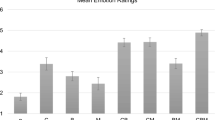Abstract
In an investigation of the role of body experience in emotion, subjects were asked to indicate where in their bodies they had experienced a particular instance of each of 10 emotions. The instances concerned either recollected emotion occurrences or actual occurrences immediately prior to report. Reports were obtained by asking the subjects to indicate their body experience in schematic drawings of the body that showed a division into 63 sections; for purposes of analysis these 63 sections were combined into 15 body areas. Patterns of experience were obtained by computing the string of frequencies with which the group of subjects had checked each area for each emotion. Patterns of reported body experiences were different for all 10 emotions studied; all but two of the pairwise comparisons were significantly different. Patterns could be readily interpreted. The evidence does not permit one to conclude that they reflect actual body experience; the reports may have reflected schematic representations of body response. The data do, however, permit the conclusion that the information contained in body experience allows distinction among the 10 emotions studied.
Similar content being viewed by others
References
Averill, J. R. (1969). Autonomic response patterns during sadness and mirth.Pyschophysiology, 5 399–414.
Ax, A. F. (1953). The psychological differentiation between fear and anger in humans.Psychosomatic Medicine, 15 433–442.
Cannon, W. B. (1927). The James-Lange theory of emotion: A critical examination and an alternative theory.American Journal of Psychology, 39 106–124.
Davis, R. C. (1957). Response patterns.Transactions of the New York Academic of Sciences, 19 731–739.
Davitz, J. R. (1969).The language of emotion. New York: Academic Press.
Ekman, P. (1973). Cross-cultural studies of facial expression. In P. Ekman (Ed.),Darwin and facial expression. New York: Academic Press.
Ekman, P., & Friesen, W. V. (1978).The Facial Action Coding System. Palo Alto: Consulting Psychologists Press.
Ekman, P., Levenson, R. W., & Friesen, W. V. (1983). Autonomic nervous system activity distinguishing among emotions.Science, 221 1208–1210.
Elshout, J. J., & Elshout, M. (1967). Marimaxcor: Methode voor clusteranalyse van correlatiematrices.Technical Report, University of Amsterdam, Department of Psychology.
Everitt, B. S. (1977).The analysis of contingency tables. London: Chapman & Hall.
Fehr, F. S. & Stern, J. A. (1970). Peripheral physiological variables and emotion: The James-Lange theory revisited.Psychological Bulletin, 74 411–424.
Frijda, N. H. (1986). The emotions. New York: Cambridge University Press.
Frijda, N. H. (1987). Emotion, cognitive structure and action tendency.Cognition and Emotion (in press).
Hohmann, G. W. (1966). Some effects of spinal cord lesions on experienced emotional feelings.Psychophysiology, 3 143–156.
Izard, C. E. (1971).The face of emotion. New York: Appleton-Century-Crofts.
Izard, C. E. (1977).Human emotions. New York: Plenum.
James, W. (1884). What is an emotion?Mind, 9 188–205.
Laird, J. D. (1974). Self-attribution of emotion: The effects of expressive behavior on the quality of emotional experience.Journal of Personality and Social Psychology, 29 475–486.
Laird, J. D. (1984). The real role of facial response in the experience of emotion: A reply to Tourangeau and Ellsworth, and others.Journal of Personality and Social Psychology, 47 909–917.
Leventhal, H. (1979). A perceptual-motor processing model of emotion. In P. Pliner, K. R. Blankstein, & J. M. Spigel (Eds.),Perception of emotion in self and others (pp. 1–46). New York: Plenum Press.
Mandler, G. (1975).Mind and emotion. New York: Wiley.
Mandler, G., & Kremen, I. (1958). Autonomic feedback: A correlational study.Journal of Personality, 26 388–399.
Mandler, G., Mandler, J. M., Kremen, I., & Sholiton, R. D. (1961). The response to threat: Relation among verbal and physiological indices.Psychological Monographs, 75, (9), Whole No. 513.
Mandler, G., Mandler, J. M. & Uviller, E. T. (1958). Autonomic feedback: The perception of autonomic activity.Journal of Abnormal and Social Psychology, 56 367–373.
Mason, R. F. (1959). Three studies relating internal sensory experiences and feeling reactions.Journal of General Psychology, 60 211–228.
Mason, R. F. (1961).Internal perception and bodily functioning: Relationship between psychological states and physiological processes. New York: International Universities Press.
Pennebaker, J. W. (1982).The psychology of physical symptoms. New York: Springer.
Roseman, I. (1984). Cognitive determinants of emotion: A structural theory. In P. Shaver (Ed.),Review of personality and social psychology: Vol. 5. Emotions, relationships, and health (pp. 11–36). Beverly Hills: Sage.
Schachter, S. (1964). The interactions of cognitive and psychological determinants and emotional state. In L. Berkowitz (Ed.),Advances in experimental social psychology (Vol. 1, pp. 49–80). New York: Academic Press.
Schachter, S., & Singer, J. A. (1962). Cognitive, social and physiological determinants of emotional state.Psychological Review, 63 379–399.
Schwartz, G. E., Weinberger, D. A., & Singer, J. A. (1981). Cardiovascular differentiation of happiness, sadness, anger and fear following imagery and exercise.Psychosomatic Medicine, 43 343–364.
Shields, S. A. (1984). Reports of bodily changes in anxiety, sadness, and anger.Motivation and Emotion, 8 1–22.
Smith, C. A. & Ellsworth, P. C. (1985). Patterns of cognitive appraisal in emotion.Journal of Personality and Social Psychology, 48 813–838.
Tomkins, S. S. (1962).Affect, imagery and consciousness. Vol. I. The positive affects. New York: Springer.
Tourangeau, R., & Ellsworth, P. (1979). The role of facial response in the experience of emotion.Journal of Personality and Social Psychology, 37 1519–1531.
Wenger, M. A. (1950). Emotion as visceral action: An extension of Lange's theory. In M. L. Reymert (Ed.),Feelings and emotions: The Mooseheart symposium. New York: McGraw-Hill.
Wenger, M. A., & Cullen, T. D. (1958). ANS response patterns to fourteen stimuli.American Psychologist, 13 423–424.
Author information
Authors and Affiliations
Additional information
Now deceased.
Rights and permissions
About this article
Cite this article
Nieuwenhuyse, B., Offenberg, L. & Frijda, N.H. Subjective emotion and reported body experience. Motiv Emot 11, 169–182 (1987). https://doi.org/10.1007/BF00992342
Issue Date:
DOI: https://doi.org/10.1007/BF00992342




